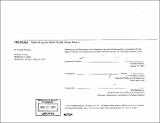| dc.contributor.advisor | Ann Pendleton-Jullian. | en_US |
| dc.contributor.author | Dickson, Amanda, 1974- | en_US |
| dc.contributor.other | Massachusetts Institute of Technology. Dept. of Architecture. | en_US |
| dc.date.accessioned | 2005-10-14T19:44:11Z | |
| dc.date.available | 2005-10-14T19:44:11Z | |
| dc.date.copyright | 2003 | en_US |
| dc.date.issued | 2003 | en_US |
| dc.identifier.uri | http://hdl.handle.net/1721.1/29301 | |
| dc.description | Thesis (M.Arch.)--Massachusetts Institute of Technology, Dept. of Architecture, 2003. | en_US |
| dc.description | Includes bibliographical references (p. [88]-[93]). | en_US |
| dc.description.abstract | Train travel was once integral to the urban condition. Railway stations and rural depots were designed as machines for efficiency and it was within the station that one could escape the chaos of the city to become a part of the streamlined systematization of the industrial age. The terminal, it was thought, existed as an extension of the infrastructure of the railroad and as an integral part of the metropolitan corridor. As such, the architecture of the station re sided within the two dimensional network ascribed to the city and to the Western and Midwestern landscape. This thesis explores the amplification of a static rail station typology into a dynamic and multifaceted urban organism that is activated in its integration of multiple infrastructures operating at multiple speeds of travel-- from airplane to high-speed train to subway to bus to car to pedestrian. Its mediation of multiple notions of arrival and departure results in a public space highly charged with activity; it is a connector, a facilitator, a non-place. The station program includes access to three underground subway lines (one proposed), on-grade bus connections, a secure high-speed airport train with baggage and ticket check-in, a portion of the pedestrian walkway which snakes underground through Chicago's loop, and a connection to the elevated rail. The exterior poche of the station building houses theaters and restaurants, shops, bars, and a hotel. Within this urban program hunkers a secure zone- waiting rooms and restaurants, newspaper kiosks and conference rooms linked hermetically to the secure airport connector train and ultimately to O'Hare Airport's gates. | en_US |
| dc.description.statementofresponsibility | by Amanda Dickson. | en_US |
| dc.format.extent | 83, [11] p. | en_US |
| dc.format.extent | 6635614 bytes | |
| dc.format.extent | 6635422 bytes | |
| dc.format.mimetype | application/pdf | |
| dc.format.mimetype | application/pdf | |
| dc.language.iso | eng | en_US |
| dc.publisher | Massachusetts Institute of Technology | en_US |
| dc.rights | M.I.T. theses are protected by copyright. They may be viewed from this source for any purpose, but reproduction or distribution in any format is prohibited without written permission. See provided URL for inquiries about permission. | en_US |
| dc.rights.uri | http://dspace.mit.edu/handle/1721.1/7582 | |
| dc.subject | Architecture. | en_US |
| dc.title | VELO[city] : rethinking the multi-modal urban station | en_US |
| dc.type | Thesis | en_US |
| dc.description.degree | M.Arch. | en_US |
| dc.contributor.department | Massachusetts Institute of Technology. Department of Architecture | |
| dc.identifier.oclc | 52414608 | en_US |
